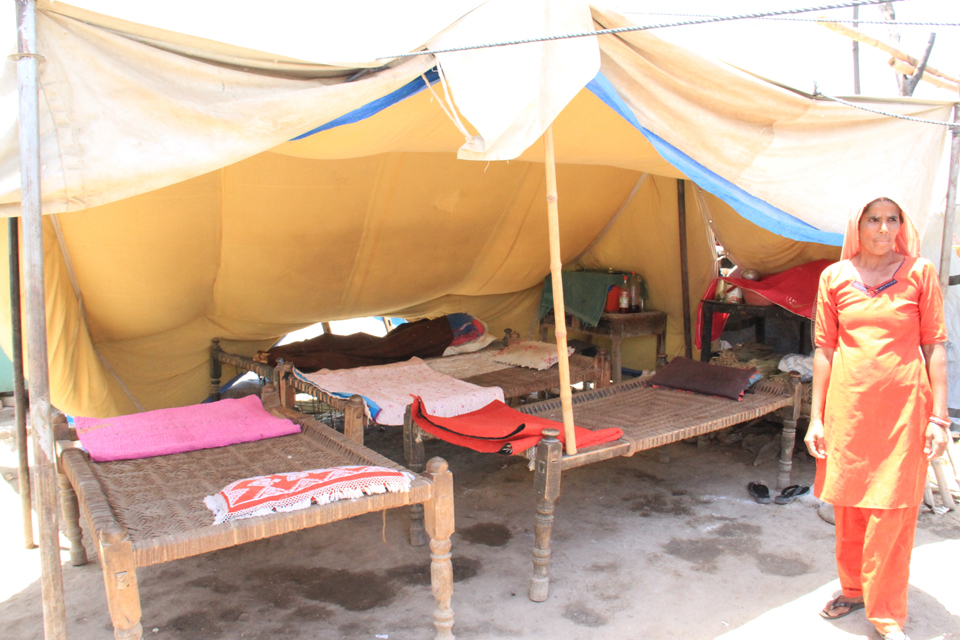Our house - Pakistan floods one year on
Helping to build flood-resistant houses across Pakistan

Sabiha Khatoon stands outside her soon-to-be completed new home in Mehar Channa village, in Pakistan's Sindh province. Picture: Vicki Francis/DFID
Sabiha Khatoon lives in a tent with her husband and 5 children in Mehar Channa village in Sindh, Pakistan. Her new brick home, funded by UK aid, is nearly ready for her family to move into.
Escaping the flood
“We thankfully had no deaths in the flood, but lost everything except the clothes on our back,” she remembers. ”We went to an emergency camp in a school in Radhan, 35 km away from the village. We stayed there for 4 months, in a tent, before moving back to a camp nearer to our village last December. In February we moved the tent back in to our village and have been here since.”
Mehar Channa village was devastated by the floods last year, with most of the mud (kichar) homes washed away and crops and livestock lost. People who lived in the village had to flee their homes when the flood waters arrived in the middle of the night, leaving everything behind and moving away to safer areas - some going to emergency tented camps and others going to stay with family in towns and cities across Sindh province.

The way we used to live: Sabiha stands outside the tent she soon hopes to leave for more permanent accommodation. Picture: Vicki Francis/DFID
Protection from the elements
Sabiha continues: “In March we were approached by Concern about building a brick house for us. We had to show papers to prove the land was ours then they agreed to help build us a house. We are very happy about this because if Concern and DFID hadn’t helped us, we’d be in the hot sun in our tents.
“It was a dream for me to build this kind of house, before we’ve always lived in kichar houses. This house is much better than what we had before as it has steel girders and is made of bricks. Our biggest fear is heavy rain and winds; this will protect us - our old house didn’t. If we didn’t have a brick house this summer would be hell. It also means in the future we can bring electricity in to this village.
“We also received fertiliser and seeds, and new hand pumps. Clean water means it is now easy to get clean drinking water and we can wash our clothes daily, and we can grow seeds given to us. We are growing sagar, we will make bread from it. We are very thankful to people in the UK for the help they gave us.”
Building back better
Mehar Channa village is now back on its feet with all its residents in, or about to move into, new permanent homes, and with livestock replaced. Improvements have also been made to what life was like for the inhabitants before the floods - including building toilets in the village, which mean women no longer have to walk half-an-hour into the fields to find privacy like they did before help from the UK.
“After the floods last July, we provided initial emergency relief to Mehar Channa village, including blankets, food, health and hygiene kits, temporary toilets, plastic sheets, mosquito nets,” explains Shama Shaik, programme officer for the NGO Concern.
“After people returned home we started reconstruction activity, and, with DFID’s help, we started construction of 22 shelters in April. We also gave poultry, fodder, cash grants for women headed households, and helped people re-start their businesses again. So in this village we have many interventions funded by UK aid.

Sabiha now has access to clean drinking water thanks to a nearby hand pump provided by UK aid. Picture: Vicki Francis/DFID
“After people returned home, UK aid provided one room permanent shelters, poultry to the females, some goats, water facilities including hand pumps and latrines. UK aid also distributed fodder, rice seeds, and wheat seeds, through these communities are able to restart their lives, they are very thankful to the UK.”
Facts and stats
UK aid is helping build 22 new brick flood resistant houses for people in Mehar Channa village who lost their homes in the floods. UK aid also provided Mehar Channa and other villages with hand pumps for clean drinking water, toilets, chicken and goats, animal feed, and seeds to grow vegetables and crops. In total, UK aid has provided shelter to more than 1 million people since the floods hit Pakistan last summer - initially tents and emergency shelter, now building brick houses which will more resilient against future floods.
UK aid is helping build 13,400 flood resistant houses across Pakistan. Each home has 1 large room, big enough to house a family of up to 8. They are flood resistant, with raised cement foundations 3 feet high and built with bricks rather than the traditional mud and straw.